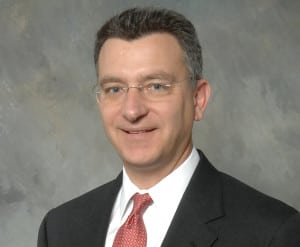
Joseph Ensor, VP and general manager of Northrop Grumman’s space ISR systems division. Photo: Northrop Grumman
[Via Satellite 04-20-2015] Northrop Grumman recently decided to divide its Intelligence, Surveillance, Reconnaissance and Targeting Systems division (ISR&TSD) in two, separating satellite systems from those that are airborne. The pivot back to separate divisions returns the company to the way it was structured prior to sequestration and the budget cuts that acutely impacted many defense contractors. This change is a signal that the company sees growth opportunities on the horizon.
“A little over three years ago we combined the divisions. We combined the airborne and space divisions together because at the time we were talking about sequestration and the budgets going forward. There was a lot of uncertainty into whether the defense budget would continue to stay as the line item it was or to shrink,” Joseph Ensor, recently appointed vice president and general manager of Northrop Grumman’s space ISR systems division, told Via Satellite. “Fortunately for us we were very successful in capturing new business along the way and really never saw that downturn.”
Ensor has executive responsibility over division programs and operations in the states of Maryland, California and Colorado. Michael Hinkey, previously Northrop Grumman’s vice president and general manager of engineering, manufacturing and logistics, has charge of the company’s airborne ISR and targeting systems division. As vice president and general manager, he has executive responsibility for programs and operations in Maryland and Illinois.
After bracing for a decline in government demand, Ensor said the company continued to grow to the point that the space division essentially ran out of room. Last year Northrop Grumman broke ground on a new building dubbed the Maryland Space Assembly and Test (M-SAT) facility. The $20-million site, scheduled for completion later this year, enables the company to conduct more space projects.
“It was at the beginning of this year that we decided to go back to the way we were, since [the space division] was about 40 percent of the entire sector in terms of sales. It was a large division and by going back to the way we were, we can better focus on our concentrations in both space and airborne,” Ensor said.
Once complete, the M-SAT facility allows the company to do a higher level of integration and assembly on its own. In the past, Northrop Grumman had to ship parts to other facilities. Ensor said the new structure provides room to build up payload assemblies at a higher level and ship projects to satellite primes as a larger payload assembly rather than as black boxes, or to integrate full satellites instead of just payloads.
Though now considered a distinct part of the company, Northrop Grumman’s space ISR division will continue to have some overlap with the airborne ISR&TSD, Ensor said. The two focus areas always shared a factory between product lines, and often the company will seek to vet technologies on airborne systems prior to using them in the space environment. Ensor described the reclassification as more of a splitting of human resources and said the two divisions would continue to work collaboratively when beneficial.
“We leverage technologies across all of our divisions and sectors. As far as individual programs there is no overlap, but there is a synergistic approach in the way we develop technology. We really try to get as much commonality across our product lines as we can,” he said.
Northrop Grumman has grown in some restricted space markets over the past five year, with many of those programs now transitioning into manufacturing, integration and testing phases. And while the new M-SAT facility is designed largely for government customers, Ensor said some small satellite companies have also shown interest.
“We’ve been approached and are in discussions with some of the commercial space providers. It would be a market adjacency for us right now because we aren’t in that particular business arena, but I would say that we do have an interest in exploring it, and our technology is transferable into those business arenas as well,” said Ensor.
He added that Northrop Grumman sees continued demand from government customers and budding opportunity in the commercial sector that validates recent moves.
“If we didn’t see this long-term growth in the market we certainly wouldn’t be making the investments that we are doing and restructuring,” he said.
The post Northrop Grumman Confident in Long Term Satellite ISR Demand appeared first on Via Satellite.